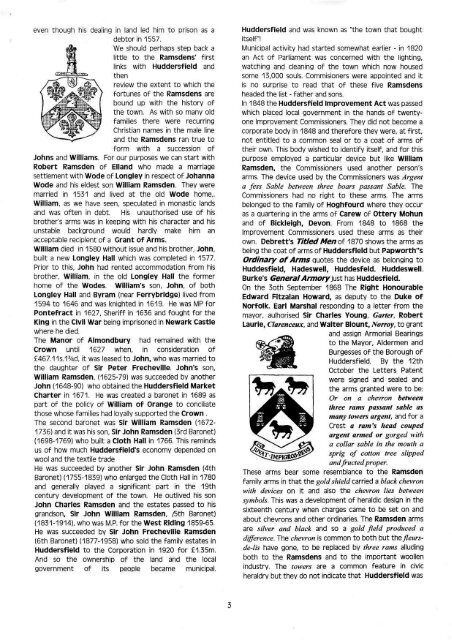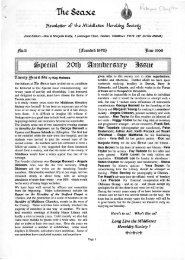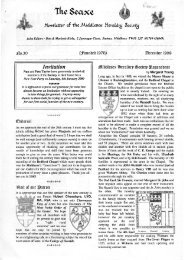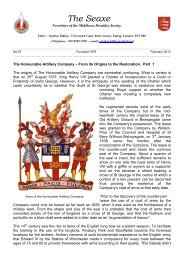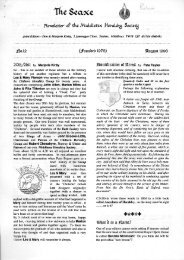The Seaxe - Middlesex Heraldry Society
The Seaxe - Middlesex Heraldry Society
The Seaxe - Middlesex Heraldry Society
You also want an ePaper? Increase the reach of your titles
YUMPU automatically turns print PDFs into web optimized ePapers that Google loves.
even though his dealing in land led him to prison as a<br />
debtor in 1557.<br />
We should perhaps step back a<br />
little to the Ramsdens' first<br />
links with Huddersfield and<br />
then<br />
review the extent to which the<br />
fortunes of the Ramsdens are<br />
bound up with the history of<br />
the town. As with so many old<br />
families there were recurring<br />
Christian names in the male line<br />
and the Ramsdens ran true to<br />
form with a succession of<br />
Johns and Williams. For our purposes we can start with<br />
Robert Ramsden of Elland who made a marriage<br />
settlement with Wode of Longley in respect of Johanna<br />
Wode and his eldest son William Ramsden. <strong>The</strong>y were<br />
married in 1531 and lived at the old Wode home,.<br />
William, as we have seen, speculated in monastic lands<br />
and was often in debt. His unauthorised use of his<br />
brother's arms was in keeping with his character and his<br />
unstable background would hardly make him an<br />
acceptable recipient of a Grant of Arms.<br />
William died in 1580 without issue and his brother, John,<br />
built a new Longley Hall which was completed in 1577.<br />
Prior to this, John had rented accommodation from his<br />
brother, William, in the old Longley Hall the former<br />
home of the Wodes. William's son, John, of both<br />
Longley Hall and Byram (near Ferrybridge) lived from<br />
1594 to 1646 and was knighted in 1619. He was MP for<br />
Pontefract in 1627, Sheriff in 1636 and fought for the<br />
King in the Civil War being imprisoned in Newark Castle<br />
where he died.<br />
<strong>The</strong> Manor of Almondbury had remained with the<br />
Crown until 1627 when, in consideration of<br />
£467.11s.1¾d, it was leased to John, who was married to<br />
the daughter of Sir Peter Frecheville. John's son,<br />
William Ramsden, (1625-79) was succeeded by another<br />
John (1648-90) who obtained the Huddersfield Market<br />
Charter in 1671. He was created a baronet in 1689 as<br />
part of the policy of William of Orange to conciliate<br />
those whose families had loyally supported the Crown .<br />
<strong>The</strong> second baronet was Sir William Ramsden (1672-<br />
1736) and it was his son, Sir John Ramsden (3rd Baronet)<br />
(1698-1769) who built a Cloth Hall in 1766. This reminds<br />
us of how much Huddersfield's economy depended on<br />
wool and the textile trade<br />
He was succeeded by another Sir John Ramsden (4th<br />
Baronet) (1755-1839) who enlarged the Cloth Hall in 1780<br />
and generally played a significant part in the 19th<br />
century development of the town. He outlived his son<br />
John Charles Ramsden and the estates passed to his<br />
grandson, Sir John William Ramsden, (5th Baronet)<br />
(1831-1914), who was M.P. for the West Riding 1859-65.<br />
He was succeeded by Sir John Frecheville Ramsden<br />
(6th Baronet) (1877-1958) who sold the family estates in<br />
Huddersfield to the Corporation in 1920 for £1.35m.<br />
And so the ownership of the land and the local<br />
government of its people became municipal.<br />
3<br />
Huddersfield and was known as "the town that bought<br />
itself"!<br />
Municipal activity had started somewhat earlier - in 1820<br />
an Act of Parliament was concerned with the lighting,<br />
watching and cleaning of the town which now housed<br />
some 13,000 souls. Commissioners were appointed and it<br />
is no surprise to read that of these five Ramsdens<br />
headed the list - father and sons.<br />
In 1848 the Huddersfield Improvement Act was passed<br />
which placed local government in the hands of twentyone<br />
Improvement Commissioners. <strong>The</strong>y did not become a<br />
corporate body in 1848 and therefore they were, at first,<br />
not entitled to a common seal or to a coat of arms of<br />
their own. This body wished to identify itself, and for this<br />
purpose employed a particular device but like William<br />
Ramsden, the Commissioners used another person's<br />
arms. <strong>The</strong> device used by the Commissioners was Argent<br />
a fess Sable between three boars passant Sable. <strong>The</strong><br />
Commissioners had no right to these arms. <strong>The</strong> arms<br />
belonged to the family of Hoghfourd where they occur<br />
as a quartering in the arms of Carew of Ottery Mohun<br />
and of Bickleigh, Devon. From 1848 to 1868 the<br />
Improvement Commissioners used these arms as their<br />
own. Debrett's Titled Men of 1870 shows the arms as<br />
being the coat of arms of Huddersfield but Papworth"s<br />
Ordinary of Arms quotes the device as belonging to<br />
Huddesfield, Hadeswell, Huddesfeld. Huddeswell.<br />
Burke's General Armory just has Huddesfield.<br />
On the 3oth September 1868 <strong>The</strong> Right Honourable<br />
Edward Fitzalan Howard, as deputy to the Duke of<br />
Norfolk. Earl Marshal responding to a letter from the<br />
mayor, authorised Sir Charles Young, Garter, Robert<br />
Laurie, Clarenceux, and Walter Blount, Norroy, to grant<br />
and assign Armorial Bearings<br />
to the Mayor, Aldermen and<br />
Burgesses of the Borough of<br />
Huddersfield. By the 12th<br />
October the Letters Patent<br />
were signed and sealed and<br />
the arms granted were to be:<br />
Or on a chevron between<br />
three rams passant sable as<br />
many towers argent, and for a<br />
Crest a ram's head couped<br />
argent armed or gorged with<br />
a collar sable in the mouth a<br />
sprig of cotton tree slipped<br />
and fructed proper.<br />
<strong>The</strong>se arms bear some resemblance to the Ramsden<br />
family arms in that the gold shield carried a black chevron<br />
with devices on it and also the chevron lies between<br />
symbols. This was a development of heraldic design in the<br />
sixteenth century when charges came to be set on and<br />
about chevrons and other ordinaries. <strong>The</strong> Ramsden arms<br />
are silver and black and so a gold field produced a<br />
difference. <strong>The</strong> chevron is common to both but the fleursde-lis<br />
have gone, to be replaced by three rams alluding<br />
both to the Ramsdens and to the important woollen<br />
industry. <strong>The</strong> towers are a common feature in civic<br />
heraldry but they do not indicate that Huddersfield was


